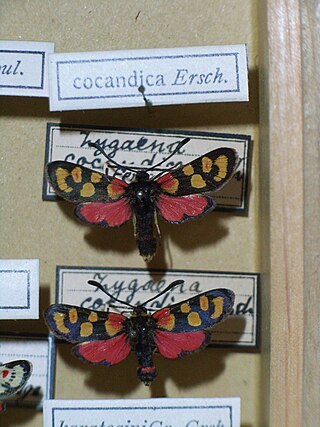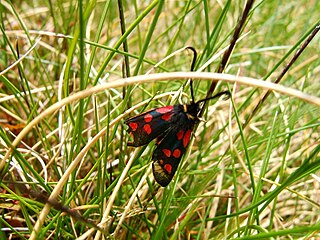
Zygaena transalpina is a moth of the family Zygaenidae.

Zygaena is a genus of moths in the family Zygaenidae. These brightly coloured, day-flying moths are native to the West Palearctic.

Zygaena carniolica, sometimes described as the crepuscular burnet or eastern burnet, is a member of the family Zygaenidae.

Zygaena ephialtes is day-flying species of burnet moth found in Europe. It is typically found in xeric habitats, and populations have recently decreased. It also exhibits Müllerian mimicry with other species, like Amata phegea.

Zygaena fraxini is a moth of the family Zygaenidae.It is a Palearctic confined to Western Asia.

Zygaena purpuralis, the transparent burnet, is a moth of the family Zygaenidae.

Zygaena occitanica, the Provence burnet, is a moth of the Zygaenidae family. It is found from the Algarve and southern Spain up to the eastern parts of the Cantabrian Mountains then to southern Russia and the Caucasus and east to the western fringe of Central Asia.

Zygaena cocandica is a moth of the family Zygaenidae. It is found in Uzbekistan, Tajikistan and Kyrgyzstan. In Seitz it is described as "A very remarkable form with yellow spots on the forewing, only the basal ones being shaded with red, it has sometimes an entirely red abdomen ab.karategini Gr.-Grsh., from Buchara" Also in Seitz as erschoffi Stgr. it is described as having "spots 5 and 6 often widely separate, standing side by side rather than one below the other; collar and 1-2 abdominal segments red, sometimes also the shoulders, as in our last figure: Pamir". The length of the forewings is about 12 mm.

Zygaena sarpedon is a moth of the Zygaenidae family. It is found in France, Italy and on the Iberian Peninsula.

Zygaena brizae is a species of moth in the Zygaenidae family. It is found in France, Italy, Austria, the Czech Republic, Poland, Slovakia, Hungary, the Balkan Peninsula, Moldova, Ukraine, Russia, Turkey and Georgia.

Zygaena punctum is a species of moth in the family Zygaenidae. It is found in Poland, the Czech Republic, Slovakia, Austria, Slovenia, Italy, the Balkan Peninsula, Moldova, Ukraine, Russia and Turkey.

Zygaena anthyllidis is a species of moth in the Zygaenidae family. It is found in France and Spain.

Zygaena rhadamanthus is a species of moth in the Zygaenidae family. It is found in France, Spain, Portugal and Italy.

Zygaena magiana is a species of moth in the Zygaenidae family. It is found in Central Asia.

Zygaena olivieri is a species of moth in the Zygaenidae family. It is found in Syria, Armenia and Georgia. Seitz describes it -In olivieri Boisd. (7h) not only the collar and 2—8 abdominal segments are red but also the patagia, the red spots of the forewing being very large; from Syria and Armenia.In subspecies Z. o. laetifica Herrich-Schäffer, 1846 the pairs of spots on forewing are separate. — In Z. o. ganimedes Freyer, [1851] from Amasia, the penultimate pair of spots and the apical patch are rather broadly connected and the red markings of the forewing have a white edge of about 1 mm width.

Zygaena formosa is a species of moth in the Zygaenidae family. It is found in Asia minor, Syria and Turkey.In Seitz it is described. — The colour of the wings of the much smaller [than the similar Zygaena olivieri group ] formosa H.-Sch. (7i), from Asia Minor and Syria, is far lighter pale rosy, the abdomen, however, being black except a narrow belt. — In malatiana Stgr. [now Zygaena formosa ssp. malatiana Rebel, 1901 ] (7h) this belt is broader, comprising the 2—3 penultimate segments; Malatia, east of the Antitaurus.

Zygaena felix is a species of moth in the Zygaenidae family. It is found in south Spain and the Atlas Mountains. In Seitz it is described. — In felix Oberth., from Algiers and South-West Spain, the black spots are more or less confluent, the red ground-colour along the distal margin being sometimes separated as a sock-like halfmoon. The white edges are usually altogether absent, or there are only feeble vestiges of them — In ab. faustula Stgr.-Reb.[ now Z. felix ssp. constantinensis Reiss & Tremewan, 1964] on the contrary the black spots are distinctly edged with yellowish white. — Lastly, ab.mauretanica Stgr. [now Z. felix ssp. constantinensis Reiss & Tremewan, 1964] (8a) has a red belt. — The 3 forms tly exactly at the same time and the same places; I found them frequently united in copula. They are extremely common throughout June on nearly all the heights of the Atlas Mts., sometimes the one sometimes the other form being prevalent in the various flight-places.

Zygaena loyselis is a species of moth in the Zygaenidae family. It is found in the Atlas Mountains.
Zygaena aurata is a species of moth in the family Zygaenidae. It is found in the Atlas Mountains of Morocco. In Seitz it is described Z. aurata as a form of favonia with glossy brass-yellow ground-colour: discovered in Julv in the Moroccan Atlas.

Zygaena niphona is a species of moth in the Zygaenidae family. It is found in the east Palearctic. In Seitz it is described Z. niphona Btlr. (6e). The only Burnet from East Asia. Rather large, sparsely scaled, 5 spotted, with rather wide red abdominal belt. Club of antenna strongly incrassate at apex. The insect has the appearance of a large meliloti, but the body is strong and robust, the flight however being nevertheless not at all fast. Though the species varies considerably, some specimens being 6 spotted and resembling therefore Z. peucedani, there are no local races. The abdominal belt occupies mostly 2 segments, but is sometimes restricted to one segment, the posterior portion of the abdomen being occasionally all red. The species is widely distributed in Japan, especially at low altitudes of the central mountains, near and on the Fujisan; probably more sporadic in Amurland, since Graeser did not meet with it.

















